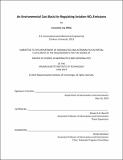An Environmental Cost Basis for Regulating Aviation NOx Emissions/
Author(s)
Miller, Cassandra Joy.
Download1292944513-MIT.pdf (3.928Mb)
Other Contributors
Massachusetts Institute of Technology. Department of Aeronautics and Astronautics.
Terms of use
Metadata
Show full item recordAbstract
Nitrogen oxides and carbon dioxide are two by-products of combustion in aircraft engines, and have different impacts on the environment. Nitrogen oxides (NO[subscript x]) are both an air quality concern and an indirect contributor to radiative forcing, while carbon dioxide (CO₂) is a long-lived greenhouse gas The International Civil Aviation Organization has been responsible for evaluating and setting commercial aircraft NO[subscript x] emissions standards since 1981 Each of the historical standards has been more stringent than the previous and, when implemented, requires newly certified engines to produce less NO[subscript x] per unit rated thrust Each iteration has been defined as a function of engine overall pressure ratio, which then links the engine cycle, and implicitly fuel burn and CO₂ emissions, to allowable NO[subscript x] levels These regulations have historically been evaluated and implemented with a focus on reducing adverse air quality impacts around airports, but the thermodynamic tradeoff with CO₂ requires additional analysis to quantify net climate impacts This paper introduces a social cost basis for evaluating aviation NO[subscript x] emissions regulations, and quantifies air quality damage, climate damage, and fuel costs associated with allowable emission levels. The result is monetized environmental and fuel costs associated with certain emission standards. Results show higher overall pressure ratio engines operating at the current NO[subscript x] regulatory limit are allowed more environmental damage per unit rated thrust than lower overall pressure ratio engines, therefore allowing uneven social costs per unit thrust (i e fuel and environmental costs combined) across the engine design space This is a consequence of the definition of the regulation today, where higher pressure ratio engines are allowed higher NO[subscript x] emissions Alternative regulation definitions are evaluated which consider the engine cycle and combustor together. Achieving constant social costs requires the regulation to decrease in slope at higher pressure ratios, corresponding to the diminishing marginal efficiency improvements, instead of increasing slope in that region.
Description
This electronic version was submitted by the student author. The certified thesis is available in the Institute Archives and Special Collections. Thesis: S.M., Massachusetts Institute of Technology, Department of Aeronautics and Astronautics, June, 2019 "x" for NOx in title is "subscript x." Cataloged from the official PDF of thesis. Includes bibliographical references (pages 43-44).
Date issued
2019Department
Massachusetts Institute of Technology. Department of Aeronautics and AstronauticsPublisher
Massachusetts Institute of Technology
Keywords
Aeronautics and Astronautics.